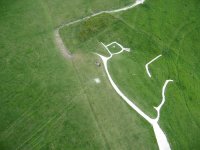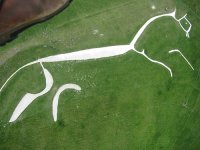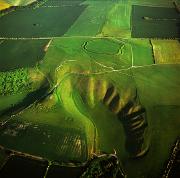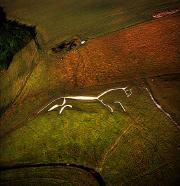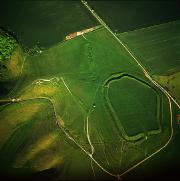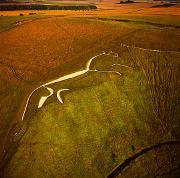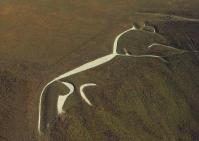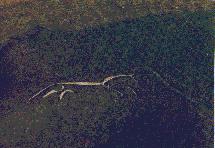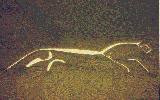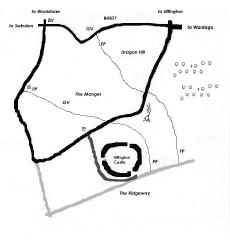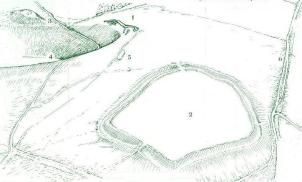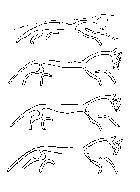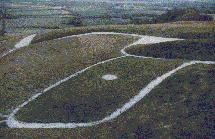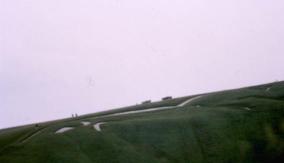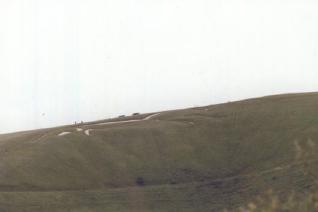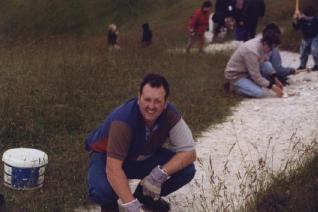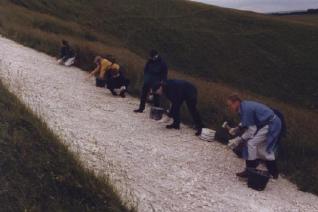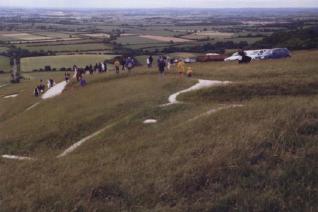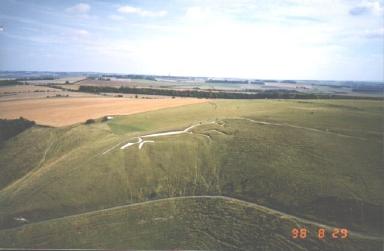Uffington White Horse
General Information
National Grid Ref SU SU 302 866
The Uffington white horse can be found 1.5 miles due south of Uffington village on the Berkshire downs (although now in Oxfordshire). It is situated facing NW near the top (at approx. 800 ft) of a very impressive steep escarpment below the Ridgeway long distance footpath, Whitehorse hill and the Saxon hillfort of Uffington castle and above Dragon hill. There is convenient parking nearby at Woolstone hill and at Whitehorse hill. This high locale makes the horse difficult to view from close quarters (although it can be seen quite well from some parts of the B4507), it is seen rather better from most areas of the Vale of the White Horse.
The best view is undoubtedly from the air, but lacking aerial capabilities the best view is from about 1 mile to the North, although the view from Dragon hill is not bad. It is also the largest of the horses being some 374 feet in length and 110 feet in height, constructed of trenches which are 5 to 10 feet in width and 2 to 3 feet deep and filled with chalk, this is a few feet above the natural chalk of the hill. The horse is in excellent condition being maintained by the National Trust. The edges are well defined partially consolidated with concrete (although well hidden) and the top edge reinforced with polypropylene netting, the chalk white and well compacted and erosion repaired when necessary.
The horse was scoured on the 24th June 2000
Aerial Photos
Reproduced with kind permission of David Price
Reproduced with kind permission of Dae Sasitorn and Adrian Warren - www.lastrefuge.co.uk
Many Thanks to Bob Croxford for the above photo. The photo is copyright Bob Croxford www.atmosphere.co.uk
History.
The Uffington white horse is undoubtedly Britainís oldest and most famous hill figure, which has recently been dated at 3000 years old by the Oxford Archeological Unit. 1000 years older than previously thought. This the oldest hill figure and inspired the creation of many of the other white horses although and particularly its closeness to Uffington castle may have inspired the creation of the first Westbury horse by Bratton camp, which also faced right. The earliest reference to it was in in the 1070's when white horse hill was mentioned, the first actual reference to the horse itself was in 1190.
The horse is unique in its features, the horse being a very long sleek disjointed figure and this leads some to believe it represents the mythical dragon that St. George slain on the adjacent Dragon hill or even his horse. However others believe it represents a Celtic horse goddess Epona, known to represent fertility, healing and death. It may have been created to be worshipped in religious ceremonies. Similar horses feature in Celtic jewelry and there is also evidence for horse worship in the Iron Age. The scouring of the horse is believed to have been a religious festival in later times, giving more creditability to the figure being of religious origin. Others believe that it commemorates Alfredís victory over the Danes in 861 AD or that it was created in the seventh century by Hengist in the image of a horse on his standard, however the recent scientific data upon its age seem to discount these more modern theories. Several Iron age coins bearing representations of horses very similar to the Uffington horse have been found and would support the theory of the horse being from an earlier period than the seventh or eight centuries.
Also unusual is the fact that the horse faces to the right while all other horses and other animal hill figures face left, with three exceptions, the very first Westbury horse, the Osmington horse and the more modern Bulford Kiwi. The earliest record of the white horse is from Abingdon Abbey in the late 12th century, although white horse hill was mentioned a century earlier. There are many records after this period with a very good historical record from the 18th century in which the horse has changed little in appearance from then to the present day. There were occasions when the horse became overgrown, 1880 for example and was in danger of being lost like some of the other hill figures. There is no danger of this happening now, with English Heritage caring for this Ancient monument.
Maps
Courtesy the National Trust
Key
1 - Uffington White Horse
2 - Uffington Castle
3 - Dragon Hill
4 - The Manger
5 - Burial Mounds
6 - Ridgeway
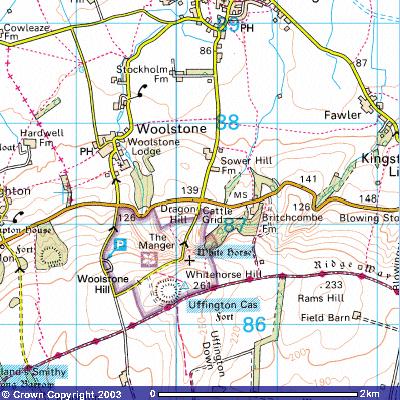
Image produced from the Ordnance Survey Get-a-map service. Image reproduced with kind permission of Ordnance Survey and Ordnance Survey of Northern Ireland.
Diagram
Photos
Close Up Photos of the Horse
The Horse from the B4507
Restoration in June 2000
Photo courtesy of Ron Dobree-Carey and Mel Morris Jones
